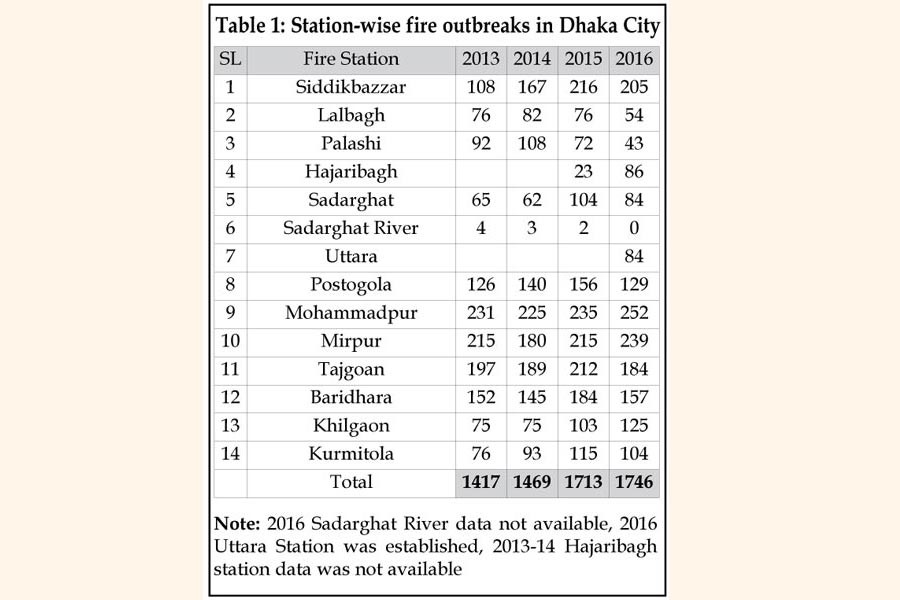With 53 million urban population by the end of 2030, Dhaka will be the number six growing megacity in the world. However, the question is-is the city prepared for natural and/or manmade disasters like earthquake and fire incidents? Does the present infrastructure-housing, road networks, capacity of the rescuers, and modern equipment facilities-maintain any standard code? Recent incidents (e.g. earthquakes in 2016, 2018; and fire incidents at Nimtoli in 2010, Chawkbazar in 2019) gave wake-up calls to the government, policymakers, academics, urban planners and general citizens to rethink possible policy implications of certain disasters. Particularly, the Chawkbazar fire incident did not only take 70 valuable lives and injured many more but also raised questions about our preparedness in disaster management.
At Chawkbazar, badly damaged was the Hazi Wahed Mansion, a five-storied building with chemicals stored. The chemical caused the fire to spread quickly within few seconds and burnt three other buildings including a community centre. This event in Chawkbazar is strikingly similar to the Nimtoli fire incident that occurred in 2010 claiming 124 lives. Both places are located in Old Dhaka and the nature of the buildings and roads is similar to each other. Then the question arises-why did a similar incident occur in less than 10 years. Did the policymakers fail to learn lessons from the past 'accident'? Or did the people fail to alert themselves to avoid such irreparable losses?
Old Dhaka is identified as a vulnerable area for natural and manmade hazards. Informal and unplanned settlements, narrow streets, a significant number of old buildings, lack of open spaces, population density, flammable building materials, electrical wire and chemical factories in residential areas also increased the vulnerability. As a tradition, Old Dhaka is characterised with various economic activities such as plastic manufacturing industries, warehouse of flammable materials like chemicals and plastic that can trigger a fire hazard. Due to the shortage of land, it is difficult to identify the residential and commercial areas and most of the buildings are used for both purposes. Building owners rent their first 2-3 floors including the basement for business purposes from where they are said to be getting a huge amount of money. Businessmen were seen to be using basement, first and second floors as warehouses, markets and factories respectively.
Furthermore, high voltage electric cables and poles with transformers are installed so close to their outer walls that it helps fire spread to the building within a short time. Moreover, traffic rush on the narrow roads always create obstacles in disaster management. BRAC Institute of Governance and Development (BIGD), BRAC University, in its 'State of Cities 2017' report on "Housing in Dhaka" found that the annual monetary loss due to fire accidents was very high in Dhaka compared to other urban centres in Bangladesh as the city has the highest concentration of economic activities. Also the data shows that the frequency of fire incidents in Dhaka City has increased about 1.21 times from 2013 to 2016 (up to September). The aggregated value of fire incidences was calculated based on the 14 fire stations in Dhaka City. Among 14 stations, five stations (e.g. Mohammadpur, Mirpur, Siddikbazar, Tejgoan, Baridhara) were found to be more vulnerable compared to other stations (Table 1). Interestingly most of the fire stations in Old Dhaka (e.g Lalbagh, Palashi, Sadarghat, Hajaribagh, Postogola) were less vulnerable but the severity of fire incidents was much higher due to the physical, spatial and higher concentration of population as well as buildings.
Previous fire incidences in residential and slum areas, shopping centres, markets, restaurants, institutions, factories etc. indicate the threat to lives as well as the economic loss. The BIGD report also stated that about 95 per cent of the respondent residents have no fire exits in their buildings. Among those 5.0 per cent who reported to have fire exits, 75 per cent replied that they did not have any sign on the exit ways.
Every year Bangladesh Fire Service and Civil Defence organises fire drills in different areas to prepare the residents for sudden disasters. However, findings of this report show that about 99.3 per cent households did not participate in any fire drill in last 2.0 years. It also shows that about 70 per cent households have no specific knowledge regarding surviving during fire incidence.
In conclusion, the brief discussion above shows Dhaka has a huge deficiency, when it comes to instruments, infrastructure, human resources, etc. and also lacks adequate knowledge, policy, rules, regulations, behavior, etc. in managing disasters like a fire. The lacking is not only on the supply side (central and local government, related departments etc.) but more on the demand side i.e. the inhabitants' knowledge, attitudes and practice. Thus, the possible way-out in managing fire hazards in Dhaka demands a holistic approach and measures from all parties involved. Some of such measures could be as follows:
* Regular training for citizens to improve their knowledge about survival strategy during the certain hazards like fire and earthquake
* Bangladesh Fire Service and Civil Defence needs to organise more fire drills in residential, commercial, educational institutions to avoid the casualty. It is high time to implement the "Dhaka Mahanagar Building (Construction, Development, Protection and Removal) Rule' 2008" to construct new buildings which according to the policy should have alternative exit ways for emergency purposes.
* RAJUK has published a Detailed Area Plan (DAP) for Dhaka metropolitan development activities and RAJUK should enforce their plan for building a livable Dhaka by incorporating and implementing rules and regulations related to management of certain hazards. Particularly, implementing roles should be given to the local government institutions such as City Corporations, Ward Councils and local communities.
Shanawez Hossain, Ph.D. is Research Fellow & Head of Urban, Climate Change and Environment (UCCE) Cluster, BRAC Institute of Governance and Development (BIGD), BRAC University


